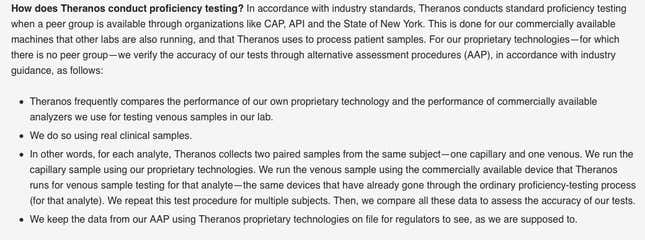Theranos has finally responded, at exhaustive length, to the accusations leveled in John Carreyrou’s deeply reported piece (paywall) questioning the blood testing firm’s business model, and the validity of its tests.
On its website, Theranos responds point by point to Carreyrou’s claims, which include allegations that the company has exaggerated how well its technology has worked, and that there are irregularities in how it conducts proficiency testing. Theranos highlights what it says are mistruths or misunderstandings in the piece, and attempts to cast doubt on Carreyrou’s sourcing. But it appears to be missing the one thing that could truly restore confidence in the company’s tests: data.
Specifically, data comparing results from the company’s proprietary finger prick tests to those from standard tests done using venous draws and commercially available equipment. The company says it collects exactly that data, and makes it available to regulators. From its response:

Right now, as it attempts to transition to FDA oversight, the company is only conducting one of its hundreds of tests, for herpes, using its proprietary technology and “Nanotainer” tubes.
With so many questions about the test from the Wall Street Journal and from customers, why not share the data?
Quartz reached out to Theranos about whether it plans to release such data, but did not receive a response in time for publication.
There is some limited data analysis on the company’s performance available on the site, which was up prior to this most recent response. It shows what it calls “representative clinical correlations,” presumably how the company’s tests compare to reference methods. The correlations and charts look very nice. But charts alone—with little or no information on what exactly is being compared to what, if these are all or in part finger prick data, sample size, and where the reference data comes from—are not terribly useful.
A source at Theranos told Quartz that the charts above had been previously available on the site on a different, less prominent page (specifically the “Providers” tab), but have been moved to the more visible “Our Labs” page featured on the company’s homepage.
Just because the company has the right to keep its data secret doesn’t mean it should, especially now.
